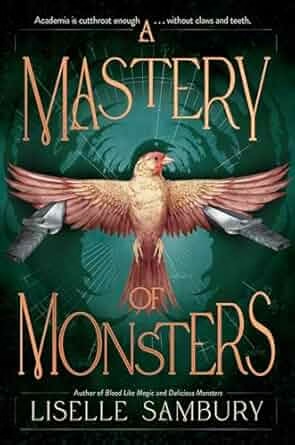A Mastery of Monsters
Liselle Sambury
Margaret K. McElderry
Published July 29, 2025
Amazon | Bookshop | Goodreads
About A Mastery of Monsters
Ninth House meets Legendborn in this thrilling first book in a dark academia fantasy series about a teen who’s willing to do anything to find her brother—even infiltrate a secret society full of monsters.
When August’s brother disappears before his sophomore semester, everyone thinks the stress of college got to him. But August knows her brother would never have left her voluntarily, especially not after their mother so recently went missing.
The only clue he left behind was a note telling her to stay safe and protect their remaining family. And after August is attacked by a ten-foot-tall creature with fur and claws, she realizes that her brother might be in more danger than she could have imagined.
Unfortunately for her, the only person with a connection to the mysterious creature is the bookish Virgil Hawthorne…and he knows about them because he is one. If he doesn’t find a partner to help control his true nature, he’ll lose his humanity and become a mindless beast—exactly what the secret society he’s grown up in would love to put down.
Virgil makes a proposition: August will join his society and partner with him, and in return, he’ll help her find her brother. And so August is plunged into a deadly competition to win one of the few coveted candidate spots, all while trying to accept a frightening reality: that monsters are real, and she has to learn to master them if she’s to have any hope of saving her brother.
My Review
I was really on the edge about whether or not to read this book. It’s almost 600 pages, and I tend to struggle with longer books like that. I had heard such great things about the author, though, that I decided to give the book a try.
Sometimes when I read a long book, I find myself skimming large sections and thinking the book could easily have been 100 pages shorter. I did not do that with A Mastery of Monsters. So. Much. Happens. In this book. It’s nonstop packed with action from start to finish.
August is such an intricately crafted character. She’s still reeling from grief over her mom’s disappearance, but she also has this (understandable) complex where she hyperfixates on fears of disappointing people. Those fears end up becoming a self-fulfilling prophecy as she self-sabotages again and again. Her distrust of others and lone-wolf mentality were so easy to relate to.
In the story, August becomes involved with a group called the Learner’s Society. It’s supposed to seem very high brow and elitist, and yet has these ideals of equity and inclusiveness. Right away, August has questions. It feels like a cult to her, and though she needs them to help her find her brother, she’s committed not to trust the organization. I loved that tension between her and the group.
I thought the ending was also well-balanced. It answers the questions that the premise promised and introduces a new conflict for readers to look forward to in the second book. If the next book is as long as this one, I don’t know whether or not I’ll continue with the series.
Conclusion
I enjoyed the story. I think the length was warranted. It’s just hard for me to commit that much time to one book at this point in my reading life, so we’ll see. I think contemporary fantasy fans will really enjoy this book.
Content Notes
Recommended for Ages 14 up.
Profanity/Crude Language Content
Strong profanity used here and there.
Romance/Sexual Content
Kissing.
Spiritual Content
Some characters transform into monsters. If they bond with a non-monster person, through a special ritual, the non-monster can help the monster retain control of their actions and change back into a human form. A select few have the ability to control any monster, even those they haven’t bonded with. Powerful items offer the ability to control monsters.
Violent Content
Situations of peril. Brief graphic descriptions of monster-induced injuries. Brief graphic descriptions of combat.
Drug Content
The opening scene shows a drunk college girl leaving a club and heading for her dorm. August also gets drunk to escape heightened grief or overwhelm. A couple other scenes show college students sharing a glass of wine.
Note: This post contains affiliate links, which do not cost you anything to use but help support this blog. I received a free copy of this book in exchange for my honest review. All opinions are my own.
